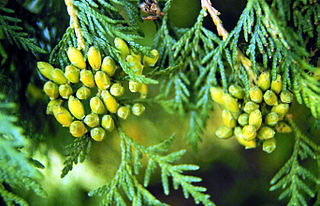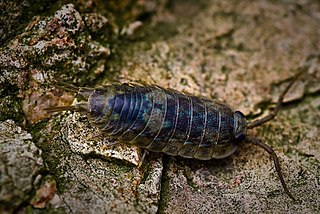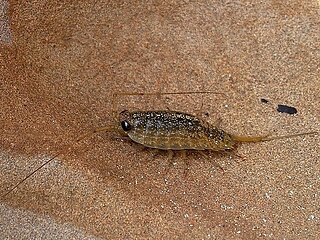
The western grebe is a species in the grebe family of water birds. Folk names include "dabchick", "swan grebe" and "swan-necked grebe".

Platanus occidentalis, also known as American sycamore, American planetree, western plane, occidental plane, buttonwood, and water beech, is a species of Platanus native to the eastern and central United States, the mountains of northeastern Mexico, extreme southern Ontario, and extreme southern Quebec. It is usually called sycamore in North America, a name which can refer to other types of trees in other parts of the world; in the United Kingdom, for example, the name syacamore typically refers to Acer pseudoplatanus. The American sycamore is a long-lived species, typically surviving at least 200 years and likely as long as 500–600 years.

Thuja occidentalis, also known as northern white-cedar, eastern white-cedar, or arborvitae, is an evergreen coniferous tree, in the cypress family Cupressaceae, which is native to eastern Canada and much of the north-central and northeastern United States. It is widely cultivated as an ornamental plant. It is not to be confused with Juniperus virginiana.

The western fence lizard is a species of lizard native to Arizona, New Mexico, and California, as well as Idaho, Nevada, Oregon, Utah, Washington, and Northern Mexico. The species is widely found in its native range and is considered common, often being seen in yards, or as the name implies, on fences. As the ventral abdomen of an adult is characteristically blue, it is also known as the blue-belly. Two western fence lizards have been reported with duplicated or forked tails, presumably following an autotomy.

The western gull is a large white-headed gull that lives on the west coast of North America and the Pacific Ocean. The western gull ranges from British Columbia, Canada, to Baja California, Mexico.

The western conifer seed bug, sometimes abbreviated as WCSB, is a species of true bug (Hemiptera) in the family Coreidae. It is native to North America west of the Rocky Mountains but has in recent times expanded its range to eastern North America, to include Ontario, Québec, New Brunswick, Nova Scotia, Michigan, Maine, Pennsylvania, New York, Connecticut, Massachusetts, New Hampshire, Ohio, Indiana, and Wisconsin, and has become an accidental introduced species in parts of Europe and Argentina.

The northwestern wolf, also known as the Mackenzie Valley wolf, Alaskan timber wolf, or Canadian timber wolf, is a subspecies of gray wolf in western North America. Arguably the largest gray wolf subspecies in the world, it ranges from Alaska, the upper Mackenzie River Valley; southward throughout the western Canadian provinces, aside from prairie landscapes in its southern portions, as well as the Northwestern United States.

Celtis occidentalis, commonly known as the common hackberry, is a large deciduous tree native to North America. It is also known as the nettletree, beaverwood, northern hackberry, and American hackberry. It is a moderately long-lived hardwood with a light-colored wood, yellowish gray to light brown with yellow streaks.

Cephalanthus occidentalis is a species of flowering plant in the family Rubiaceae that is native to eastern and southern North America. Common names include buttonbush, common buttonbush, button-willow, buck brush, and honey-bells.

Ligia oceanica, the sea slater, common sea slater, or sea roach, is a woodlouse, living in the littoral zone—rocky seashores of the European North Sea and Atlantic coastlines.
Odontophrynus occidentalis, commonly known as the Cururu lesser escuerzo, is a species of frog in the family Odontophrynidae. It is endemic to western and central Argentina. Its natural habitats are montane forests, montane grasslands, rocky outcrops, and shrubland. Breeding takes place in permanent streams; the development of the tadpoles takes about eight months. It tolerates habitat change but is threatened by water pollution and fires caused by agriculture and mining.

Senna occidentalis, commonly known as coffee senna, styptic weed, or septicweed, is a species of flowering plant in the family Fabaceae and is native to the southern United States of America, Mexico and South America. It is a shrub with pinnate leaves, with three to seven pairs of broadly elliptic to egg-shaped leaflets, and yellow flowers arranged in groups of two to four, with six fertile stamens in each flower. It is an aggressive, pantropical weed.

Ligia is a genus of isopods, commonly known as rock lice or sea slaters. Most Ligia species live in tidal zone cliffs and rocky beaches, but there are several fully terrestrial species which occur in high-humidity environments.

Ligia exotica, also called sea roach or wharf roach, is a woodlouse-like isopod, a sea slater in the family Ligiidae. It is found in various parts of the world living on rocky coasts and harbour walls just above high water mark.

Ligia cinerascens is a woodlouse in the family Ligiidae.

The long-tailed shrew or rock shrew is a small shrew found in Atlantic Canada and the Northeastern United States.
Arbutus occidentalis or the Mexican Madrone is a small tree species in the heath family, that is endemic to Mexico. It is only known from a few areas in Western Mexico where it grows on rocky slopes. It produces red edible berries that are valuable food to wildlife.

Eucalyptus occidentalis, commonly known as the flat topped yate or the swamp yate, is a tree that is native to Western Australia. The Noongar names for the tree are Mo or Yundill.

Ligia pallasii, the sleepy sea slater, is a species of isopod in the family Ligiidae. It is found along the Pacific coast of North America from the Aleutian Islands to northern California.

Martino's mole is a species of small blind mole in the family Talpidae found in eastern Thrace along the western Black Sea coast in south-eastern Bulgaria and north-eastern Turkey, mainly in the Strandzha mountain range. In Bulgaria it is found in Strandzha Nature Park. Martino's mole is named in honour of the couple Evgeniya and Vladimir Martino, key earlier Balkan mammalogists.

















